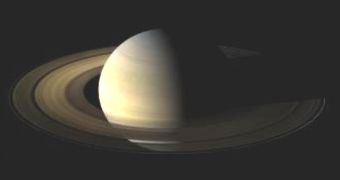Saturn, the second-largest planet in the solar system, features a large number of rings, some of which usually experience a brief “night,” lasting from six to 14 hours. At times, however, the entire ring system is engulfed by shadows, when the planet reaches its equinox. This happens once every 15 Earth years, and the latest such occurrence took place on August 11. Fortunately for us, the Cassini space probe was in orbit around the gas giant, and sent back some of the most outstanding measurements of the phenomenon's influences that astronomers ever got the chance to look at.
“The equinox is a very special geometry, where the sun is turned off as far as the rings themselves are concerned, and all energy comes from Saturn,” NASA expert Dr. Michael Flasar explains. He is a scientist at the agency's Goddard Space Flight Center, in Greenbelt, Maryland. During the recent equinox, which saw the rings shadowed for a full four days, the temperature inside the dust and ice formations dropped to -382 degrees Fahrenheit, or -230 degree Celsius, the lowest ever recorded.
Cassini's Composite Infrared Spectrometer (CIRS) instrument was responsible for taking the extremely precise measurements, which will help further our understanding of the planet. “The whole point of the CIRS observations of Saturn's rings, other than producing some cool pictures, is to learn something about the physical properties of the ring particles: their spin rates, how sluggish they are in storing and radiating heat (a diagnostic of size and composition), and their vertical distribution in the ring 'plane',” Flasar says of the observations. The expert is also the instrument's principal investigator.
“At first glance, Saturn's rings look broad and bland, but then we got close-up images from the Voyager flybys, and our reaction was: oh, my gosh, there's structure everywhere – what's going on?” Jet Propulsion Laboratory (JPL) scientist Dr. Linda Spilker asks.
A few days before and during the new equinox, Saturn observations yielded a variety of new finds that intrigued astronomers and also proved how little they actually knew about the gas giant. For example, they discovered a massive, new ring, orbiting some 13 million kilometers away from the planet's surface. They also found quirks in a number of rings, new shadows projected by some of its moons, a new moonlet inside Ring B, and a new moon in the G Ring. The scientists were mostly surprised to learn of peculiar deformities inside the rings, which they did not know to be there.
“It's like putting on 3-D glasses and seeing the third dimension for the first time. This is among the most important events Cassini has shown us,” JPL Cassini project scientist Bob Pappalardo says of the finds. “We thought the plane of the rings was no taller than two stories of a modern-day building and instead we've come across walls more than 2 miles [3 kilometers] high. Isn't that the most outrageous thing you could imagine? It truly is like something out of science fiction,” Space Science Institute Cassini imaging team leader Carolyn Porco reveals.
“The biggest surprise was to see so many places of vertical relief above and below the otherwise paper-thin rings. To understand what we are seeing will take more time, but the images and data will help develop a more complete understanding of how old the rings might be and how they are evolving,” Spilker has added at the time. Further studies of the images relayed by Cassini also revealed that moonlets were embedded in the rings, which made them invisible to normal observations. They were spotted because, during the equinox, the light fell at a very low angle on the rings.
The team also discovered that the A Ring, the outermost of the bright formations – with the exception of the newly found, massive ring around the moon Phoebe –, did not cool off as the other did, during the equinox. Spiker believes that this phenomenon may give experts a clue about the formation and structure of the ring itself. “One possibility is that the gravitational influence of moons outside the A Ring is stirring up waves in it. These waves could be much higher than the typical thickness of the rings. Since the waves rise above the ring plane, material in the waves would still be exposed to sunlight during the equinox, which would warm up the A-ring more than expected,” she explains.
“We have to carefully test this idea with computer models to see if it produces the temperatures we observed with CIRS. That's the challenge with CIRS. It's not like seeing a close-up picture of Mars, which can tell you something about its geology right away. We have to look at the CIRS data from different times and sun angles to see how the ring temperatures are changing, then make computer models to test our theories on what those temperatures say about the rings,” Spilker concludes.
The Cassini-Huygens mission is a cooperative project between NASA and the European and Italian Space Agencies. NASA JPL manages the mission for the Science Mission Directorate at the NASA Headquarters in Washington. JPL also designed, developed and assembled the Cassini orbiter and its two onboard cameras. The imaging team is based at the Space Science Institute, Boulder, Colo. The CIRS team is based at NASA Goddard. CIRS was built by Goddard, with significant hardware contributions from England and France.

 14 DAY TRIAL //
14 DAY TRIAL //